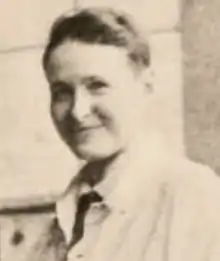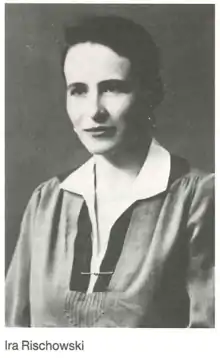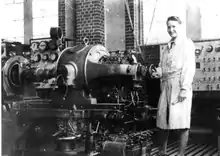Ira Rischowski
Ira (Irene) Rischowski (1 August 1899 – 1989) was one of Germany's first female engineers and active in the German anti-Nazi resistance group Neu Beginnen before fleeing to Britain.[1] In the UK she became a member of the Women's Engineering Society, serving on the Council and supporting efforts to encourage British women to become engineers.
Ira Rischowksi | |
|---|---|
 Rischowski at Darmstadt in 1919 | |
| Born | 1 August 1899 |
| Died | 1989 |
| Alma mater | Technical University, Darmstadt |
| Occupation | Engineer |
| Organization | Women's Engineering Society |

Biography
Early career
Rischowski was born in Germany in 1899 to Albert Rischowski (b. 10 January 1848 - ) and Ida née Salomonsohn (12 June 1867– 26 November 1943), the eldest of four children.[1] The family were Jewish by heritage but the children were baptised. Albert Rischowski ran shipyards and took young Ira with him to watch the riveting of the ships which inspired her to become an engineer.[1]

In 1919, Rischowski enrolled as the first female engineering student at the Technical University in Darmstadt.[2] Her successful application was supported by six months experience repairing agricultural equipment.[2] From 1928, Rischowski was employed as an engineer, following training at the electrical company Siemens-Schuckert.[2] In 1930 Rischowski became a member of Germany's central engineering institution, the Verein Deutscher Ingenieure (VDI).[2] In 1933, there was a women's section in the VDI, but Rischowski refused to join it since it was affiliated with the Nazi Party.[2]
In 2019, the Institute for Nuclear Physics at Darmstadt University created the Rischowski scholarship programme for female students in her honour.
Anti-Nazi Resistance
Rischowski joined the underground anti-fascist group Neu Beginnen in 1932 and became a key clandestine operative with codename 'Gabriele'.[3] She was responsible for encoding and decoding correspondence with comrades abroad.[3] In 1933, the group's operational office moved to Potsdamer Platz in Berlin, masquerading as an engineering consultancy.[3] Rischowski worked at disguising Marxist literature, and transferring documents to the Social Democratic Party in exile in Prague.[3]
Seeking Refuge
In September 1935, Rischowski was arrested while attempting to move banned literature to a safe place. She managed to talk herself free, but fearing surveillance, quickly fled to Prague.[4] In July 1936 she moved on to the UK through the domestic servant visa scheme.[5][6] Rischowski was invited by Caroline Haslett to attend meetings of the Women's Engineering Society, and she became an associate member in 1939.[2]
Interned for a year at the Rushen Camp on the Isle of Man as an enemy alien, she was released in 1942 and worked as a draughtsman and planning engineer, first at Tuvox Ltd and later at James Gordon Ltd, where she became Head of Projects.[7]
Family life
Rischowski met her future husband Fritz Bruno Karthäuser (1898–1973) while studying engineering at the Technical University in Darmstadt. They married in December 1922, and they had two daughters.[4] Their first child Hellen Isot was born in 1924 and their second Herta Maria (Kindi) in 1930.[8] Bruno and Ira divorced in 1933. When she was forced into exile in 1935, Rischowski left her children in the care of her elderly mother Ida in Berlin until 1938 when, with support from members of the WES, she was able to bring them both to London. Ida was deported to the Theresienstadt Ghetto where she died in 1943.[9]
On her death in 1989, the then WES President Dorothy Hatfield called Rischowski "an inspiration to us all".[2]
Family memorial
Rischowski's sister Edith Novak donated a seventeenth century silver cup, made by Hans Paulus, to the Victoria & Albert Museum, to remember "her mother Ira [sic] Rischowski, her aunt Rosa Friedlander and Hedwig Malachowski, and in gratitude for the safety found by younger members of her family in the British Commonwealth" (Ira is a mistake for Ida).[10]
References
- "Rischowski, Ira (Oral history)". Imperial War Museums. Retrieved 2020-01-23.
- humer (2019-09-19). "Ira Rischowski: refugee engineer". Electrifying Women. Retrieved 2020-01-18.
- Sandvoß, Hans-Rainer (1985). Widerstand in Steglitz und Zehlendorf (PDF). pp. 61, 83.
- "Rischowski, Ira (Oral history)". Imperial War Museums. Retrieved 2019-09-22.
- Holmes, Rose (2018). "Love, labour, loss: women, refugees and the servant crisis in Britain, 1933–1939". Women's History Review. 27:2 (2): 288–309. doi:10.1080/09612025.2017.1327096.
- Cacciottolo, Mario (2012-03-08). "Scrubbing floors to escape from Hitler". Retrieved 2019-09-22.
- "Records of the Women's Engineering Society: papers of Ira Rischowski - Archives Hub". archiveshub.jisc.ac.uk. Retrieved 2019-09-22.
- "100 Jahre Studium von Frauen an der TU Darmstadt" (PDF). 2008.
- "Holocaust Survivors and Victims Database -- Ida Rischowski". www.ushmm.org. Retrieved 2020-09-29.
- "Cup and cover | Hauer, Hans Paulus | V&A Search the Collections". V and A Collections. 2020-06-24. Retrieved 2020-06-24.